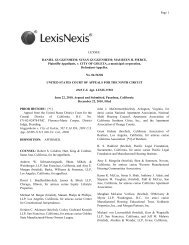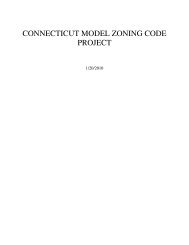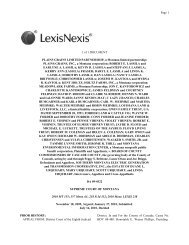Through a Glass Darkly: Measuring Loss Under ... - Land Use Law
Through a Glass Darkly: Measuring Loss Under ... - Land Use Law
Through a Glass Darkly: Measuring Loss Under ... - Land Use Law
You also want an ePaper? Increase the reach of your titles
YUMPU automatically turns print PDFs into web optimized ePapers that Google loves.
MEASURING LOSS UNDER MEASURE 37 571<br />
amount of compensation payable, but rather that the waiver is “instead<br />
of” monetary compensation. 38<br />
Combining this interpretation of subsection (8) with the “waiving<br />
regulations for all eligible claims” policy ensures that once the claimant<br />
has proven that there has been a devaluation in the fair market value of<br />
the property caused by the land use regulation (or more accurately that<br />
the local government has accepted her assertion that there has been<br />
devaluation), the magnitude of that loss is entirely irrelevant. There<br />
is little incentive for local governments to engage in a complex, timeconsuming<br />
valuation report in order to determine the exact dollar<br />
amount of loss when the magnitude of the loss ultimately will have no<br />
bearing on the remedy. The only cases in which local governments<br />
would have an incentive to scrutinize the alleged compensation carefully<br />
are borderline cases, where the question of whether there was any<br />
devaluation is at issue. However, as seen from the examples given above,<br />
there appears to be a widespread belief among most public agencies that<br />
any land use regulation that restricts the use of a property must also<br />
have resulted in a net loss to the value of the property, if only “by at<br />
least one dollar.” 39 That is, once the applicant has demonstrated the<br />
relevant antecedent formalities, including a demonstration that the regulation<br />
in question has “restrict[ed] the use of [the] property,” 40 the<br />
question of whether there has been any devaluation is, for many local<br />
authorities, as redundant as the question of magnitude of loss.<br />
III. Why Quantification Matters<br />
A discussion of the quantification of loss pursuant to Measure 37 claims<br />
may be deemed somewhat inconsequential considering that there is<br />
only one instance of an offer for payment of a monetary claim. 41 With a<br />
38. This interpretation of “in lieu of” has been confirmed in the recent partial summary<br />
judgment by Judge Don Dickey, Circuit Court of Marion County, Oregon. Vanderzanden<br />
v. <strong>Land</strong> Conservation & Dev. Comm’n, Case No. 05C19565 (Marion County,<br />
Or. Cir. Ct. Jan. 2007); Hood River Valley Residents v. State, Case No. 06C17267<br />
(Marion County, Or. Cir. Ct. Jan. 2007); Messer v. <strong>Land</strong> Conservation & Dev. Comm’n,<br />
Case No. 06C18036 (Marion County, Or. Cir. Ct. Jan. 2007).<br />
39. See, e.g., In re Grudzinski, Ballot Measure 37 Claim for Compensation (OR. REV.<br />
STAT. § 197) Staff Report and Recommendations, 13 (Nov. 23, 2005) (emphasis added),<br />
available at http://www.portlandonline.com/shared/cfm/image.cfmid100361.<br />
40. OR. REV. STAT. § 197.352(1).<br />
41. As of January 23, 2007, Portland State University’s Institute of Metropolitan Studies<br />
has documented that over 7,500 Measure 37 claims have been filed, including over<br />
750,000 acres. The total cost in compensation claimed totals $10,448,335,417. SHEILA A.<br />
MARTIN, ET AL., WHAT IS DRIVING MEASURE 37 CLAIMS IN OREGON (2007), available at<br />
http://www.pdx.edu/media/i/m/ims_M37pptApril07UAAppt.pdf.<br />
ABA-TUL-07-0701-Sullivan.indd 571<br />
9/18/07 10:43:38 AM







